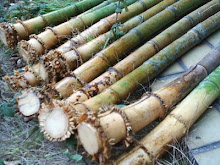I was playing the Kazan with the high blowing edge for about 10 minutes today marveling in it's wonderful response. Adjusting the depth always requires focus and serious choice making as a milimeter will affect the tone color and playability to some degree. Those with little experience may not notice a difference but experienced players can notice a huge difference in feel and sound from a 1mm difference.

When I first saw this Hanko - Kazan - Flower Mountain, I recognized it immediately. I also recalled that a fellow shakuhachi blogger over at
A Shakuhachi Journey happens to own a Kazan. So I did some detective work to see if I can get a reference picture for the depth on her Kazan.

Thanks to Erin, I got the shot! And as I started to remove, the instrument became more and more responsive and with a wider dynamic range on tone color and volume. I always feel so lucky that I can be a part of this process - helping a flute find it's original voice.

I could have played this flute all day but I had to go pick up Jet from Day Care so I deferred to Erin's photo's. I had 20 minutes to apply some Honshu Red Urushi, the original color. Honshu Red is an amazing deep red that's quite beautiful. It also takes longer to cure. It's going to sit out for 12 hours and then will go into my humid box for a about a week or more.
Check back then for a sound file.
Namaste, Perry












